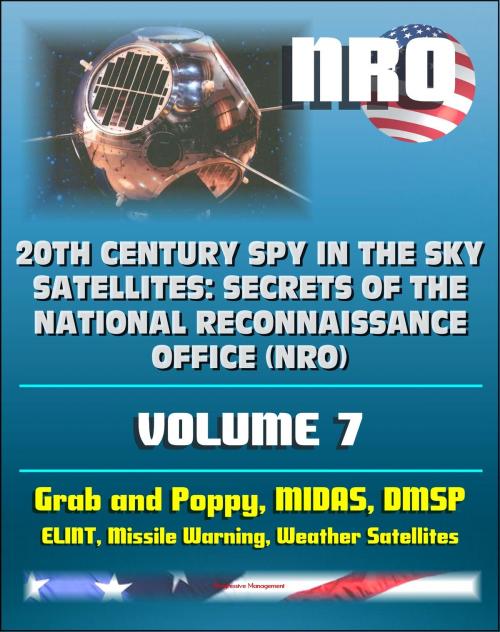20th Century Spy in the Sky Satellites: Secrets of the National Reconnaissance Office (NRO) Volume 7 - ELINT Grab and Poppy, Missile Warning MIDAS, Polar Orbiting Meteorological Satellites
Nonfiction, Science & Nature, Technology, Military Science, History, Military| Author: | Progressive Management | ISBN: | 9781466021464 |
| Publisher: | Progressive Management | Publication: | October 30, 2011 |
| Imprint: | Smashwords Edition | Language: | English |
| Author: | Progressive Management |
| ISBN: | 9781466021464 |
| Publisher: | Progressive Management |
| Publication: | October 30, 2011 |
| Imprint: | Smashwords Edition |
| Language: | English |
Part of our comprehensive series on the National Reconnaissance Office (NRO) and its "spy satellite" network, this volume covers three aspects of military satellite programs: the Grab and Poppy ELINT satellites used for electronic intelligence; the MIDAS missile defense space-based infrared early warning satellites, and a history of the military polar orbiting meteorological satellite program.
ELINT: Grab and Poppy were pioneering space reconnaissance activities during the 1960s. The intelligence these programs collected played a vital role in U.S. national security at the height of the Cold War. The programs succeeded only because of the creativity and perseverance of key contributors and others who participated in Grab and Poppy development and operation.
MIDAS: After a security and policy review, late in 1998 Lt Gen Eugene L. Tattini, Commander of the Air Force Space and Missile Systems Center, declassified MIDAS, an action that liberated its history to be shared with a much wider audience. This history compasses the origin and early years of space-based infrared (IR) sensors employed to detect the launch of ballistic missiles and, in time, the flash of ordnance detonated on Earth and in the atmosphere. It addresses the people, institutions, ideas, and machines brought to the task and their relationship to each other over a twelve-year period at the height of the Cold War, between 1955 and 1967. Beside treating the primary actions and events, it also attempts to account for the expectations and tensions that existed among the key participants: aerospace engineers who created the spacecraft and payload, their military superiors who anxiously sought an operational system, and still others in the Pentagon and Congress who doubted whether the technology would work, insisted on more research to demonstrate it, or sought to cancel the program after six ignominious flight failures.
DMSP: Successful operation of overhead photoreconnaissance satellites, the RAND Corporation had warned the Air Force in the mid-1950s, (1) depended on accurate and timely meteorological forecasts of the Sino-Soviet landmass. Such forecasts would make possible cloud-free photography over areas of interest. Indeed, pictures of clouds retrieved from a film-limited spacecraft cost dearly—a fact made plain in 1960-1961 by the images returned from early CORONA missions.
NRO designs, builds and operates the nation's reconnaissance satellites. NRO products, provided to an expanding list of customers like the Central Intelligence Agency (CIA) and the Department of Defense (DoD), can warn of potential trouble spots around the world, help plan military operations, and monitor the environment. As part of the 16-member Intelligence Community, the NRO plays a primary role in achieving information superiority for the U. S. Government and Armed Forces. A DoD agency, the NRO is staffed by DoD and CIA personnel. It is funded through the National Reconnaissance Program, part of the National Foreign Intelligence Program. The NRO Vision: Vigilance From Above. NRO Mission: Innovative Overhead Intelligence Systems for National Security. In recent years, the NRO has implemented a series of actions declassifying some of its operations. The organization was declassified in September 1992 followed by the location of its headquarters in Chantilly, VA, in 1994.
Part of our comprehensive series on the National Reconnaissance Office (NRO) and its "spy satellite" network, this volume covers three aspects of military satellite programs: the Grab and Poppy ELINT satellites used for electronic intelligence; the MIDAS missile defense space-based infrared early warning satellites, and a history of the military polar orbiting meteorological satellite program.
ELINT: Grab and Poppy were pioneering space reconnaissance activities during the 1960s. The intelligence these programs collected played a vital role in U.S. national security at the height of the Cold War. The programs succeeded only because of the creativity and perseverance of key contributors and others who participated in Grab and Poppy development and operation.
MIDAS: After a security and policy review, late in 1998 Lt Gen Eugene L. Tattini, Commander of the Air Force Space and Missile Systems Center, declassified MIDAS, an action that liberated its history to be shared with a much wider audience. This history compasses the origin and early years of space-based infrared (IR) sensors employed to detect the launch of ballistic missiles and, in time, the flash of ordnance detonated on Earth and in the atmosphere. It addresses the people, institutions, ideas, and machines brought to the task and their relationship to each other over a twelve-year period at the height of the Cold War, between 1955 and 1967. Beside treating the primary actions and events, it also attempts to account for the expectations and tensions that existed among the key participants: aerospace engineers who created the spacecraft and payload, their military superiors who anxiously sought an operational system, and still others in the Pentagon and Congress who doubted whether the technology would work, insisted on more research to demonstrate it, or sought to cancel the program after six ignominious flight failures.
DMSP: Successful operation of overhead photoreconnaissance satellites, the RAND Corporation had warned the Air Force in the mid-1950s, (1) depended on accurate and timely meteorological forecasts of the Sino-Soviet landmass. Such forecasts would make possible cloud-free photography over areas of interest. Indeed, pictures of clouds retrieved from a film-limited spacecraft cost dearly—a fact made plain in 1960-1961 by the images returned from early CORONA missions.
NRO designs, builds and operates the nation's reconnaissance satellites. NRO products, provided to an expanding list of customers like the Central Intelligence Agency (CIA) and the Department of Defense (DoD), can warn of potential trouble spots around the world, help plan military operations, and monitor the environment. As part of the 16-member Intelligence Community, the NRO plays a primary role in achieving information superiority for the U. S. Government and Armed Forces. A DoD agency, the NRO is staffed by DoD and CIA personnel. It is funded through the National Reconnaissance Program, part of the National Foreign Intelligence Program. The NRO Vision: Vigilance From Above. NRO Mission: Innovative Overhead Intelligence Systems for National Security. In recent years, the NRO has implemented a series of actions declassifying some of its operations. The organization was declassified in September 1992 followed by the location of its headquarters in Chantilly, VA, in 1994.















